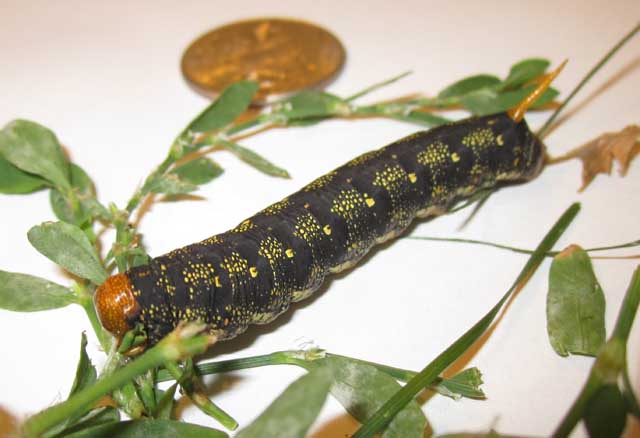Sphinginae subfamily
Sphingini tribe:
 |
Agrius cingulata,
BAMONA, Pink-spotted Hawkmoth.
Larvae feed on plants in Convolvulaceae family, especially
Ipomoea batatas (sweet potato) and Solanaceae family,
especially (Datura) (jimsonweed) and related plants. Brown form too. Look for very large, dark
spiracular circles. only as an adult stray
|
 |
Ceratomia amyntor
BAMONA,
the Elm Sphinx or Four-horned Sphinx
Larvae feed on Elm (Ulmus), birch (Betula), basswood
(Tilia), and cherry (Prunus).
There are both green and brown forms. The four horns near
the head are diagnostic. |
 |
This caterpillar is one of the few North American Sphingidae that
feed in large groups. Colouration is distinctive. The larvae
are much more spectacular than the moths. Catalpa is the larval host. |
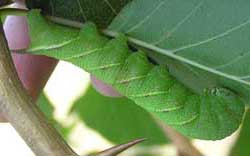 |
Ceratomia hageni
WO,
Hagen's Sphinx or Osage Orange Sphinx
Larvae feed on osage orange (Maclura pomifera), and they have a granulous appearance with variable amounts of purple
along the oblique white stripes.
|
 |
Ceratomia undulosa
BAMONA,
the Waved Sphinx
Fraxinus, Ligustrum, Quercus, Crataegus and
Chionanthus virginicus are listed as hosts.
In the fifth instar, the spiracular ovals are decidedly red and the
anal horn is off-white to pinkish laterally.
|
 |
The caterpillars are called Tomato Hornworms and each has a black horn at the end of the abdomen.
Larvae feed on potato, tobacco, tomato, and other plants in the
nightshade family (Solanaceae).
|
 |
Note the red horn and black dots anterior to the white oblique lines.
If you grow tomatoes, you have probably encountered it.
|
 | Larvae feed at night, hiding on the underside of stems during the
day. Preferred hosts are common trumpetcreeper (Campsis radicans),
Florida yellow-trumpet (Tecoma stans), lilac
(Syringa species), and passionflower (Passiflora species). Questionable
|
 |
Sphinx chersis
WO,
the Northern Ash Sphinx or Great Ash
Sphinx:
The larvae are pale bluish green. The head has a pair of yellow
lateral bands meeting at the apex. The oblique, lateral stripes are
pale and bordered anteriorly with a darker green.
Larval hosts are ash, lilac, privet, cherry, and quaking aspen.
|
 |
Larvae hide in the day and feed primarily on cherry, plum, and apple
at night. Larvae have been found on Amelanchier nantuckensis
in Massachusetts and have been reared to pupation in Michigan on
Prunus serotina. Note purple oblique lines.
|
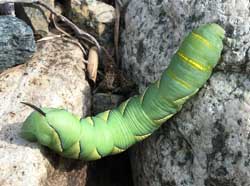 | Larvae feed on the common snowberry (Symphoricarpos albus)
and on coralberry (S. orbiculatus). Note the two golden
lines of slightly raised bumps, one just behind the head, the other
on the thorax.
|
Smerinthini Tribe:
 |
Amorpha juglandis larvae feed upon Walnut and butternut (Juglans),
hickory (Carya), alder (Alnus), beech (Fagus),
hazelnut (Corylus), and hop-hornbeam (Ostrya). |
 |
Pachysphinx modesta
BAMONA,
the Modest Sphinx or Poplar Sphinx
Larvae feed on poplars and cottonwood.
|
 |
Larvae accept willows, birches, and cherries.
I have also found them in the wild on oak in eastern Canada.
|
 |
Wild cherry species are the favorites as larval foodplants, but eggs
will also be deposited on birches and other forest trees.
There are varying degrees in the amount of red markings along the sides.
|
 |
Larvae feed upon many forest trees including birches and cherries,
but are expecially fond of poplars and willows. Red markings on sides
vary greatly from specimen to specimen.
|
Macroglossinae subfamily
Dilophonotini Tribe:
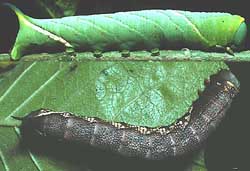 |
Aellopos titan
WO, the Titan Sphinx.
Larvae feed on seven year apple, Casasia clusiifolia, common
buttonbush, Cephalanthus occidentalis, and white indigoberry,
Randia mitis. Randia monantha, Randia aculeata,
Albizzia adinocephala and Randia grandifolia, all in the
madder family (Rubiaceae), also serve as hosts. rare adult stray only |
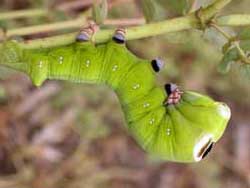 |
Erinnyis ello
WO,
the Ello Sphinx:
Larvae feed on papaya (Carica papaya), Cnidoscolus
angustidens, poinsettia (Euphorbia pulcherrima),
guava (Psidium species) and
saffron plum (Bumelia angustifolia/Bumelia celastrina).
Manilkara bahamensis,
Willow Bustic (Bumelia salicifolia)
and Painted Leaf (Poinsettia heterophylla) are also hosts.
Larvae show considerable variation. rare adult stray
|
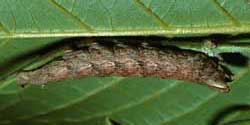 |
Erinnyis obscura, Obscure Sphinx,
BAMONA:
Larvae feed on Rauvolfia ligustrina, Rauvolfia tetraphylla,
Stemmadenia obovata, Philibertia, Cynanchum, papaya
(Carica papaya), Asclepiadaceae, Blepharodon mucronatum,
White vine (Sarcostemma clausum) and Morrenia odorata.
rare, adult stray
|
See Hemaris comparison
to help distinguish the next two species.
 |
Hemaris diffinis
BAMONA,
the Snowberry Clearwing or Bumblebee Moth.
Larval hosts: Snowberry (Symphoricarpos),
honeysuckle (Lonicera), Coralberry, viburnums, Blue Dogbane
(Apocynum) and dwarf bush honeysuckle (Diervilla lonicera).
Horn is black with a yellow base.
|
 |
Hemaris thysbe
WO,
the Hummingbird Clearwing
There is also an orangey-pink prepupal form. The lateral line runs
from S1 to the blue horn.
Hemaris thysbe larvae feed on viburnum and related plants.
generally more eastern species
|
Philampelini Tribe:
 |
Eumorpha achemon
BAMONA,
the Achemon Sphinx.
Larvae feed upon Grape (Vitis), Virginia Creeper
(Parthenocissus quinquefolia) and other vines and ivies
(Ampelopsis).
Larvae occur in both a light (green) form and a darker (tan/brown)
form. Note six "segmented" oblique lines.
|
 |
If you have Grape or Virginia Creeper nearby, then you might encounter
this species. Note the five large white ovals. There are orangey-brown and green
forms also.
unlikely |
Macroglossini Tribe:
 |
In additon to Virginia creeper larvae accept Grape (Vitis),
ampelopsis (Ampelopsis), and cayenne pepper (Capsicum).
Larvae are green until the final instar.
|
 |
Darapsa myron
BAMONA,
the Virginia Creeper Sphinx or the Grapevine Sphinx
If you have the
foodplants indicated in the common names, you probably have this
species nearby. The lower wings are orange.
Larvae feed on Virginia creeper (Parthenocissus quinquefolia),
Grape (Vitis), Ampelopsis, and Viburnum. |
 |
Deidamia inscriptum
BAMONA,
the Lettered Sphinx.
Grape (Vitis), ampelopsis (Ampelopsis), and
Virginia creeper (Parthenocissus) all serve as larval hosts.
The alternating yellow and greyish-green rings across the back
distinguish this larva.
|
 |
Hyles lineata
BAMONA/AD, the White-lined Sphinx.
Larvae: highly varied, feed on a great diversity of plants
including willow weed (Epilobium), four o'clock (Mirabilis),
apple (Malus), evening primrose (Oenothera), elm
(Ulmus), grape (Vitis), tomato (Lycopersicon),
purslane (Portulaca), and Fuschia.
All larvae seem, however, to have the red/black swellings split by
dorso-lateral lines. |
Hyles lineata mature larva, Omaha, October 2, 2011, Amy Dohmen
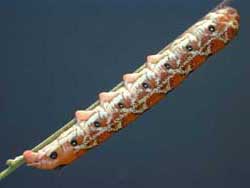 |
Proserpinus juanita
WO,
the Juanita Sphinx.
Newly-hatched caterpillars eat their eggshells. Larvae feed on
(Onagraceae) including evening primrose (Oenothera), gaura (Gaura),
and willow weed (Epilobium). Michael Van Buskirk has found them on
Guara biennis in Missouri. rare
|
 |
Sphecodina abbottii
WO, questionable,
the Abbott's Sphinx.
Larvae feed at night on grape (Vitis) and ampelopsis
(Ampelopsis) and hide on the bark of their host plants during
the day. Virginia creeper would also be a suitable host. There is also a dark form
without the green patches. Note the "raised eye", replacing the anal horn.
|
|
|
